February 23, 2012 02:51 PM | Permalink | 
Read the PDF of this report.
The Obama administration has proposed a “framework” for 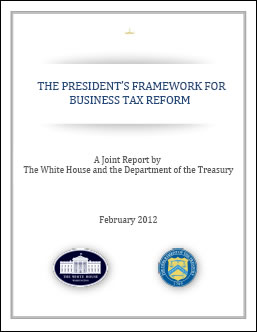 corporate tax reform. Unfortunately, it is designed to be “revenue-neutral,” meaning it would not raise needed revenue to fund public investments, protect important programs such as Social Security and Medicare, or address the budget deficit.
corporate tax reform. Unfortunately, it is designed to be “revenue-neutral,” meaning it would not raise needed revenue to fund public investments, protect important programs such as Social Security and Medicare, or address the budget deficit.
The President’s framework calls on Congress to enact reforms that would, by themselves, raise a little over a trillion dollars over a decade. But all of that revenue would be given back to corporations in the form of new tax cuts.
The President’s plan also fails to answer key questions. First, exactly which tax loopholes would be closed to offset the costs of the proposed new tax cuts and to prevent the corporate tax overhaul from becoming revenue-negative? Second, is the President really proposing to lower taxes for domestic manufacturers like Boeing that have already been allowed to avoid corporate taxes for years? Third, how does the President’s plan for addressing offshore corporate tax avoidance differ from Congressional Republicans’ plan to impose a tiny “minimum tax” on offshore profits after exempting them from the rest of the corporate tax?
Framework Does Not Attempt to Raise Needed Revenue
“The President’s Framework for Business Tax Reform” released by the Treasury Department on February 22 would not attempt to raise additional revenue from corporations to finance public investments or deficit reduction.
The framework would close corporate tax loopholes, but would use the revenue saved to pay for new tax breaks for corporations, including a reduction in the statutory corporate income tax rate from 35 percent to 28 percent. The net result, according to the President, would be no net increase or decrease in corporate tax revenue.
A “revenue-neutral” corporate tax reform should not be enacted.[1] The first goal of corporate tax reform should be to increase the overall amount of tax revenue collected from U.S. corporations, which today pay very low effective tax rates.[2] (Effective tax rates are the percentage of profits that corporations actually pay in corporate income taxes.)
CTJ recently studied most of the Fortune 500 companies that have been profitable in each of the last three years and found that their average effective tax rate during that period was just 18.5 percent.[3] Thirty of the corporations had net negative tax rates (meaning they received money from the Treasury) over the three-year period.
Corporations claim that they are overly burdened by the U.S. corporate income tax, which has a statutory rate of 35 percent. But CTJ’s data demonstrate that most profitable corporations have effective tax rates that are far lower because of the tax loopholes they enjoy.
Which Tax Loopholes Would Be Closed?
The President’s framework is very short on details about which corporate loopholes he wants to close to offset the costs of the tax breaks it includes. In other words, it’s not even clear how a corporate tax reform based on the President’s framework would avoid becoming revenue-negative.
The President has proposed to reduce the statutory corporate tax rate from 35 percent to 28 percent, make certain temporary tax breaks, including the research and experimentation credit, permanent, and add some new business tax breaks. In total, these tax cuts would cost us about $1.2 trillion over the next 10 years.[4]
Only about a fourth of the revenue-raising provisions needed to offset this cost have been specified by the administration. This $0.3 trillion in tax increases on corporations and other businesses has been proposed in detail as part of President Obama’s most recent budget proposal, which was released about a week earlier. [5] (Most of these tax increases are also described as examples of revenue-raisers in the framework.)
These revenue-raising provisions generally are good policy. For example, the framework and the budget plan would eliminate the “last in, first out (LIFO)” method of manipulating inventory accounting, the many tax subsidies for oil and gas companies, the provisions that allow insurance to be used as a tax shelter, and the “carried interest” loophole that allows wealthy fund managers to pretend they have low-tax capital gains income.
The framework and the budget plan also include some limited proposals to reduce abuses of the rule allowing U.S. corporations to “defer” U.S. corporate taxes on their offshore profits. For example, they would limit deferral of taxes on profits from “intangible” assets in tax havens where no real business is being conducted. They would also end the corporate practice of taking deductions right away against U.S. taxes for expenses related to offshore profits even as they defer U.S. taxes on those profits.
The framework only gives vague suggestions about where the other three-fourths of revenue offsets would come from. The framework hints at other ways in which Congress might find the other $0.9 trillion of revenue needed to offset the tax cuts it proposes. The possibilities include “addressing depreciation schedules” without explaining how, “reducing the bias toward debt financing” without specifying how much, and “establishing greater parity between large corporations and non-corporate counterparts.”
Each of these could be good ideas — if only the administration would lead with strong, detailed proposals. For example, “addressing depreciation schedules” could be a major improvement. Depreciation is basically the deduction a business takes against its taxable income for purchases of buildings or equipment, and since these things do not immediately lose their value (the way inventory might) the deductions are taken over a period of years. If the rules required “economic depreciation,” then companies would take these deductions as the equipment or buildings actually wear out, but in most cases the current rules allow them “accelerated depreciation” which allows them to take these deductions over a much shorter period of time. This provides a huge benefit to businesses that can even wipe out their profits for tax purposes.
The framework explains that “accelerated depreciation may be a less effective way to increase investment and job creation than reinvesting the savings from moving towards economic depreciation into reducing tax rates.” This is rather surprising coming from an administration that has proposed and enacted its share of depreciation breaks, including allowing companies to “expense” or deduct 100 percent of their investments in a single year.
To take another example, “establishing greater parity between large corporations and their large non-corporate counterparts” could greatly improve and simplify our tax system. This basically refers to the need to address businesses that are large companies but are not organized as the type of corporations that pay the corporate income tax. These businesses are often called “pass-through” entities because the profits pass through to the individual owners and are therefore subject to the personal income tax but not the corporate income tax.
The framework refers to options put forth previously by President George W. Bush’s Advisory Panel on Tax Reform and President Obama’s Economic Recovery Advisory Board. The options explored by the latter include some that are very straightforward but rather limited in scope (like treating any publicly traded company as a corporation that is subject to the corporate income tax) while others would be more far-reaching and more complex.
Determining which businesses must pay the corporate income tax will be important because many pass-through entities are very large companies — like Bechtel, the Tribune Company, many of the top lobbying firms, law firms and hedge funds. It’s difficult to believe that members of Congress will take on these behemoths without more explicit direction from the administration.
Is the President Really Proposing New Breaks for Manufacturers Who Already Avoid Taxes?
The President argues that companies that create jobs in the U.S. deserve tax breaks. However, his decision last week to hold up the aerospace and defense corporation Boeing as a company deserving lower taxes — despite its years and years of completely avoiding corporate taxes — raises more questions than it answers.
Last week, President Obama told a crowd at a Boeing plant in Washington State that companies that use tax breaks to shift operations and profits offshore ought to pay more U.S. taxes and the revenue “should go towards lowering taxes for companies like Boeing that choose to stay and hire here in the United States of America.”
Over the past ten years, Boeing has paid nothing in net federal income taxes, despite $32 billion in pretax U.S. profits. On the contrary, Boeing has actually reported more than $2 billion in negative total federal taxes over that period. Only twice in the last 10 years has Boeing reported a positive federal income tax liability. In each of the other eight years, including the last four, Boeing’s federal income taxes were negative.[6]
The President’s framework would reduce the nominal corporate tax rate for profits from domestic manufacturing to 25 percent.
This would be accomplished by changing the existing tax deduction for domestic manufacturing. The existing deduction allows companies to reduce their income for tax purposes by 9 percent of any income that comes from manufacturing in the U.S. With the current statutory corporate tax rate of 35 percent, this break reduces the effective corporate tax rate for profits from domestic manufacturing to 31.5 percent (at most).
Currently, only about two-thirds of the existing deduction for domestic manufacturing goes towards companies that the IRS characterizes as “manufacturing” companies. The other third goes towards information technology, mining, construction, utilities and many other types of companies.[7] (The 2004 law creating the deduction defined “manufacturing” quite loosely.) Apparently, this is what would change under the framework’s proposal to “focus the deduction more on manufacturing activity.”
The framework would “expand the deduction to 10.7 percent” for those companies that would still be allowed to receive it. This would lower the effective corporate tax rate for profits from domestic manufacturing from 28 percent (the statutory corporate tax rate under the framework) to 25 percent (at most). The deduction would be even more generous for “advanced manufacturing.”
Obviously, companies like Boeing, General Electric and Honeywell that have negative tax rates on their U.S. corporate profits do not need more breaks to encourage them to base their operations domestically rather than abroad.
In fact, CTJ’s recent study of Fortune 500 corporations found that about two-thirds of the corporations with significant offshore profits actually paid lower taxes on their U.S. profits than they paid to foreign governments on their foreign profits.[8] These companies already enjoy loopholes that enable them to pay lower taxes in the U.S. than they pay abroad. For these companies, taxes are apparently not the reason why they choose to conduct some of their business offshore.
Of course, there is a serious problem with some countries that have no corporate income tax at all, or an extremely low corporate income tax. These countries are offshore tax havens like the Cayman Islands or Bermuda. There is no way the U.S. can “compete” with these countries by lowering its tax rate. How the framework deals with this problem is the next question to be addressed.
How Would the International Tax Rules Differ from those Proposed by Congressional Republicans?
The administration will have to take a much firmer stance on how Congress should reform the international corporate tax rules that currently facilitate corporations shifting jobs and profits offshore. The administration must firmly oppose any move to a “territorial” tax system, which essentially would exempt U.S. corporations’ offshore profits from U.S. taxes.
The President’s framework does reject a “pure territorial system,” but since no country in the world has a truly “pure territorial system,” this does not offer much guidance.
A territorial system would increase the existing incentives for U.S. corporations to move their operations offshore or use accounting gimmicks to make their U.S. profits appear to be “foreign” profits generated in offshore tax havens.[9]
The “minimum tax” on offshore profits proposed as part of the framework may not remedy this problem at all, especially given that the administration has not even specified a rate for a minimum tax.
Indeed, the President’s framework might even be compatible with the corporate tax overhaul proposed by Dave Camp, the Republican chairman of the House Ways and Means Committee. Camp has put forward broad outlines of a plan that would enact a territorial tax system but would effectively impose a tiny 1.25 percent tax on offshore profits of U.S. corporations. Hopefully, this is not the minimum tax the administration has in mind.
Of course, the President may be contemplating a much higher “minimum” tax rate on offshore profits. This could reduce or even eliminate the incentives for corporations to shift jobs and profits offshore. But at this point, we just don’t know.
Appendix: Why Did Some News Reports Say the President’s Corporate Tax Framework Would Raise Revenue?
Some media outlets have reported that the President’s corporate tax reform “framework” would raise $250 billion over a decade. This is incorrect. The administration asserts that the combination of closing corporate tax loopholes and reducing the corporate tax rate will yield $250 billion over a decade — but then proposes to use all of this $250 billion to pay for additional tax breaks that mostly go to businesses. These tax breaks are called the “tax extenders” by Congressional insiders and lobbyists because they are temporary tax breaks that Congress extends every couple of years after they have expired. Making these breaks a permanent part of the tax code, as the administration proposes, does nothing to make our corporate income tax simpler, more efficient, or more adequate to meet our pressing budget needs.*
The confusion arises from the administration’s argument (made explicit on page 18 of the “framework”) that making these tax breaks permanent and offsetting the costs by closing corporate tax loopholes is fiscally responsible compared to Congress’s current practice of periodically extending these tax breaks without offsetting their costs at all. This sets the bar for fiscal responsibility absurdly low. Using revenue savings from corporate tax reform to finance unnecessary tax breaks for corporations and other businesses does not improve our nation’s fiscal health.
* The largest of the “tax extenders” is the research credit, a tax break that is supposed to, but has not been proven to, encourage research. See Martin A. Sullivan, “Time to Scrap the Research Credit,” Tax Notes, February 22, 2010.
[1] Last year, 250 organizations, including organizations from every state in the U.S., joined Citizens for Tax Justice in urging Congress to enact a corporate tax reform that raises revenue. Letter to Congress, May 18, 2011, https://ctj.sfo2.digitaloceanspaces.com/pdf/corptaxletter.pdf These organizations believe that it’s outrageous that Congress is debating cuts in public services like Medicare and Medicaid, allegedly to address a budget crisis, and yet no attempt will be made to raise more revenue from profitable corporations.
[2] A CTJ fact sheet explains why corporate tax reform should be revenue-positive. Citizens for Tax Justice, “Why Congress Can and Should Raise Revenue through Corporate Tax Reform,” November 3, 2011. https://ctj.sfo2.digitaloceanspaces.com/pdf/corporatefactsheet.pdf
[3] Citizens for Tax Justice, “Corporate Taxpayers & Corporate Tax Dodgers, 2008-2010,” November 3, 2011. http://ctj.org/corporatetaxdodgers
[4] The largest portion of this cost would come from reducing the corporate tax rate. The Congressional Budget Office estimates that the corporate income tax will collect $4.36 trillion over the next decade. See Congressional Budget Office, “The Budget and Economic Outlook: Fiscal Years 2012 to 2022,” January 31, 2012. http://www.cbo.gov/doc.cfm?index=12699 Reducing the corporate income tax rate from 35 percent to 28 percent would reduce corporate tax revenue by $872 billion. (35-28)/35*4,360 = 872.
[5] President Obama’s most recent budget plan would raise $350 billion over a decade through business tax reforms. See Citizens for Tax Justice, “President Obama’s 2013 Budget Plan Reduces Revenue by Trillions, Makes Permanent 78 Percent of Bush Tax Cuts,” February 14, 2012, page 4. https://ctj.sfo2.digitaloceanspaces.com/pdf/obamabudgetfy2013.pdf If the corporate income tax rate is just 28 percent (as proposed under the President’s framework), these reforms will raise less revenue than they would under the current rate of 35 percent. Under a 28 percent rate, they would raise $280 billion over a decade, roughly 0.3 trillion dollars over a decade. 28/35*350 =280.
[6] Citizens for Tax Justice, “Obama Promoting Tax Cuts at Boeing, a Company that Paid Nothing in Net Federal Taxes Over Past Decade,” February 17, 2012. https://ctj.sfo2.digitaloceanspaces.com/pdf/boeing2012.pdf
[7] Nicholas Johnson and Ashali Singham, “States Can Opt Out of the Costly and Ineffective ‘Domestic Production Deduction’ Corporate Tax Break,” January 14, 2010, page 4. http://www.cbpp.org/files/7-29-08sfp.pdf
[8] Citizens for Tax Justice, “Corporate Taxpayers & Corporate Tax Dodgers, 2008-2010,” November 3, 2011, page 10. http://ctj.org/corporatetaxdodgers
[9] A CTJ fact sheet explains why Congress should reject any proposal to exempt offshore corporate profits from U.S. taxes. Citizens for Tax Justice, “Why Congress Should Reject A ‘Territorial’ System and a ‘Repatriation’ Amnesty: Both Proposals Would Remove Taxes on Corporations’ Offshore Profits,” October 19, 2011. https://ctj.sfo2.digitaloceanspaces.com/pdf/corporateinternationalfactsheet.pdf
![]()
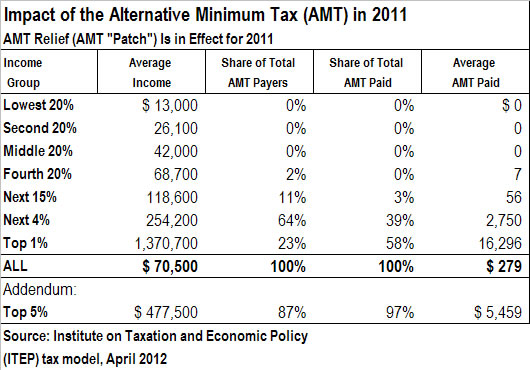




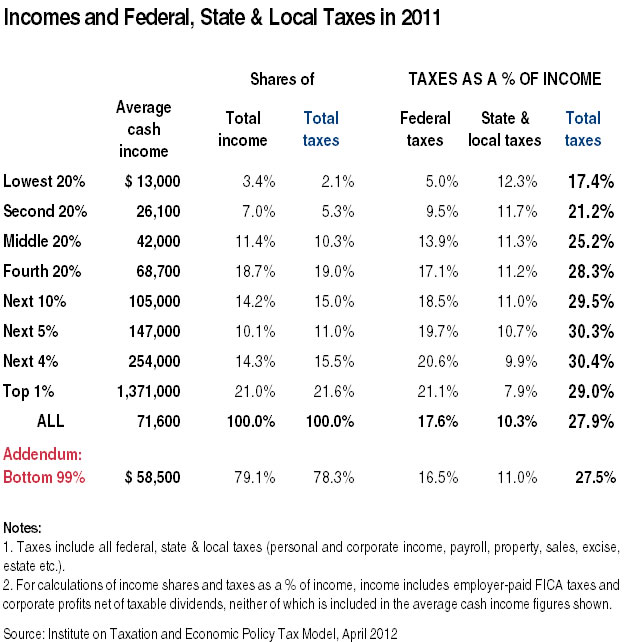
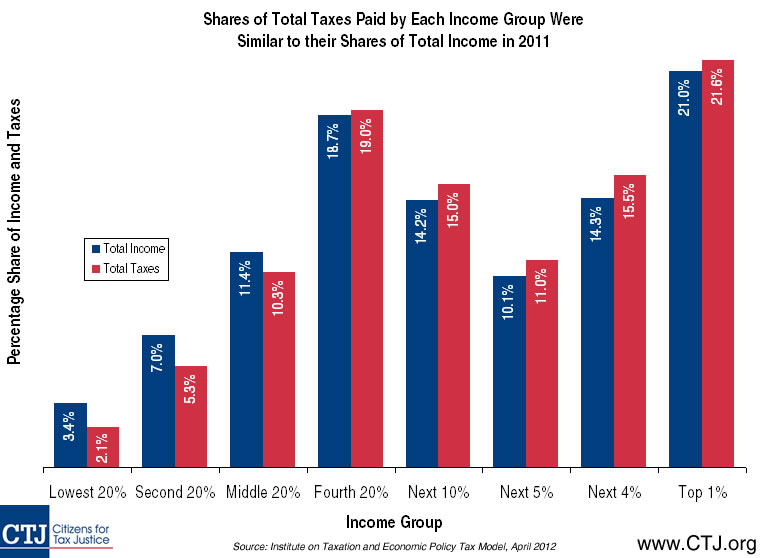
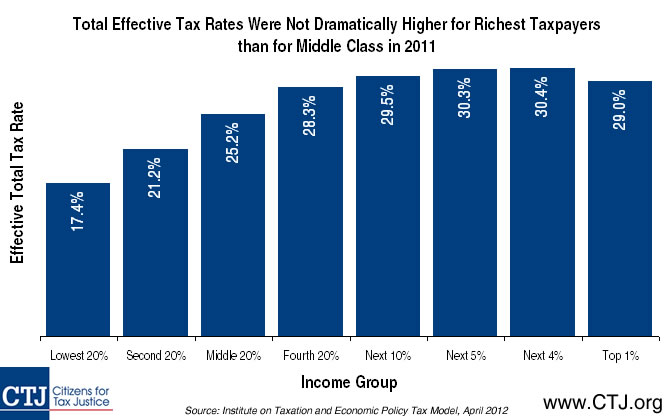
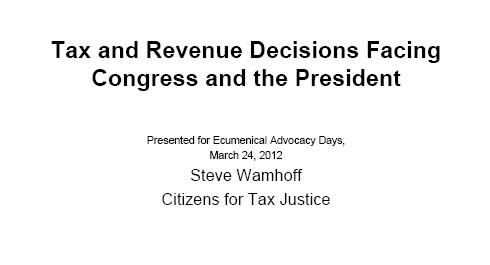

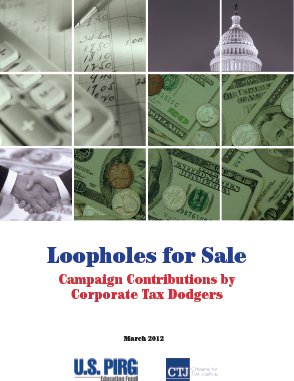
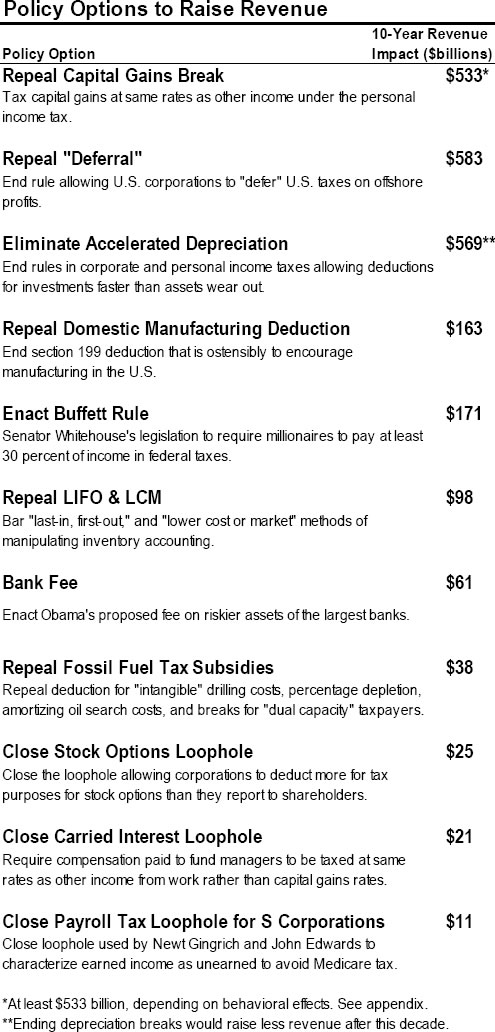
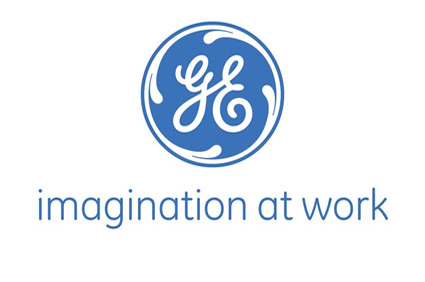 recent finding that GE had an effective federal corporate income tax rate of two percent over ten years, GE’s press office issued a short statement designed to divert attention from its tax-avoiding ways. GE has nothing to say to contradict the figures we cite from its own annual reports.
recent finding that GE had an effective federal corporate income tax rate of two percent over ten years, GE’s press office issued a short statement designed to divert attention from its tax-avoiding ways. GE has nothing to say to contradict the figures we cite from its own annual reports. corporate tax reform. Unfortunately, it is designed to be “revenue-neutral,” meaning it would not raise needed revenue to fund public investments, protect important programs such as Social Security and Medicare, or address the budget deficit.
corporate tax reform. Unfortunately, it is designed to be “revenue-neutral,” meaning it would not raise needed revenue to fund public investments, protect important programs such as Social Security and Medicare, or address the budget deficit. On February 17, the President plans to visit a Boeing plant in Washington state to tout his proposed new tax breaks for American manufacturers. This is an odd setting to discuss new tax cuts, because over the past 10 years (2002-11), Boeing has paid nothing in net federal income taxes, despite $32 billion in pretax U.S. profits.
On February 17, the President plans to visit a Boeing plant in Washington state to tout his proposed new tax breaks for American manufacturers. This is an odd setting to discuss new tax cuts, because over the past 10 years (2002-11), Boeing has paid nothing in net federal income taxes, despite $32 billion in pretax U.S. profits. President Obama’s fiscal year 2013 budget plan would cut taxes by $4.1 trillion over ten years. Most of this cost results from his proposal to make permanent 78 percent of the Bush tax cuts, which would reduce revenues by $3.5 trillion over a decade. The budget plan does include some good proposals that, together, would raise $1.1 trillion over a decade. Of course, these revenue-raising proposals don’t come close to offsetting the costs of the tax cuts.
President Obama’s fiscal year 2013 budget plan would cut taxes by $4.1 trillion over ten years. Most of this cost results from his proposal to make permanent 78 percent of the Bush tax cuts, which would reduce revenues by $3.5 trillion over a decade. The budget plan does include some good proposals that, together, would raise $1.1 trillion over a decade. Of course, these revenue-raising proposals don’t come close to offsetting the costs of the tax cuts.